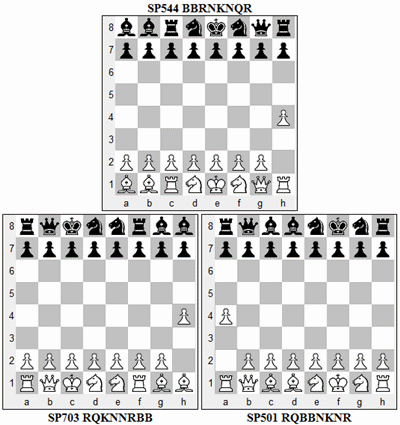In the traditional chess start position, the move 1.b4 has its dedicated adherents, while 1.g4 is considered dubious, despite a small number of fans. The moves 1.h4 and 1.a4 are both considered to be even worse than 1.g4. In chess960, the boundaries between good first moves and poor first moves shift depending on the start position. GM Nakamura opened with 1.h4 or 1.a4 in three games recorded on ICC:-
- SP544 BBRNKNQR: 2002.10.25, Smallville - JelenaDokic
- SP703 RQKNNRBB: 2009.07.27, Smallville - OfficeMan
- SP501 RQBBNKNR: 2004.08.10, Smallville - McShane
At first I wasn't going to consider the game played in 2002, because it is Nakamura's earliest recorded chess960 ICC game. The choice of 1.h4 might have been a youthful indiscretion played for no particular reason. Then I looked at the game, shown in the top diagram below. With the two Bishops aimed at the opponent's h-side and the Queen-Rook sitting behind the g-/h-Pawns, the move 1.h4 launches an immediate attack. White's aggressive opening strategy is apparent already on the first move.

The two bottom diagrams are from the later games. In SP703, the pieces on the a-/b-/g-/h-files mirror the same pieces in SP544. The two positions would be twins if the King and a Knight were switched. Following the logic in SP544, White could have played 1.a4, but 1.h4 was played again, apparently to develop the Black-squared Bishop via h2.
In SP501, the Rook-Queen pair is again in the corner, this time without the dynamics in the opposite corner. White played 1.a4, followed by 2.Ra3 and 3.b4 on the next two moves. For his initial moves, Black pushed Pawns in the center and ultimately won. It was the only game of the three where Nakamura did not prevail.
What can be learned from these three examples? First, that a game's strategy starts on the very first move. Second, that the strategy should pay some attention to classical opening principles. Third, that White can use the initial tempo to try something offbeat. But we already knew all that from traditional chess, didn't we.

No comments:
Post a Comment